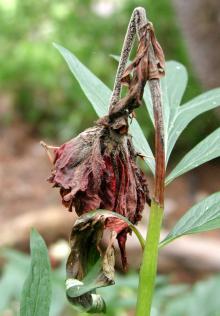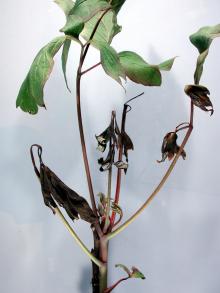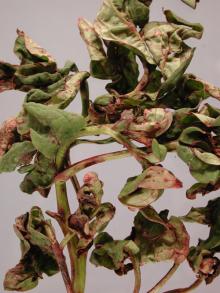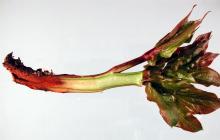Cause The fungi Botrytis paeoniae (sometimes called early blight or bud blast) and B. cinerea (sometimes called late blight). Additional species have been found in the PNW including B. pseudocinerea that is resistant to fenheximide. Inoculum of B. paeoniae will be from previous or nearby peony crops while that of B. cinerea could be from any of its over 250 hosts. These fungi are favored by wet, rainy conditions that result in free moisture on plant surfaces. The first conidia arise from sclerotia that have overwintered on the surface of decayed peony foliage. Subsequent spores are produced on infected plant material. Spores can be blown by wind, splashed by rain, or carried on tools. Conidia enter the host through natural openings, directly, or through wounds. The fungi can colonize peony petals and other plant tissues. These tissues, especially petals, can be the source of the fungus when they fall onto healthy leaves. They will form black, overwintering structures called sclerotia, which can survive in plant debris left over or mulched around the bases of plants. There is a wide range of susceptibility in various cultivars of peony.
Symptoms Early blight-young shoots can rot as they come through the ground or at the base when only a few inches high. Shoots may appear to suddenly wilt and fall over. A dense, velvety gray fungal growth usually covers the rotting portions. Flowers are attacked at any stage. Buds may turn black before they develop or may be blasted when half open. Flowers infected late turn brown. Blackened buds or flowers may continue to rot down the stem. Stems develop a concentric brown and tan zoned appearance. Leaf spots may develop when infected petals fall on foliage. Later in the year, small, shiny black, slightly loaf-shaped sclerotia form near the base of infected stalks, just under the epidermis.
Late blight-similar, but it usually affects only flowers that open late. The fungus produces a sparse mycelial growth that stands far out from infected tissues. This is in contrast to the dense, tightly compressed growth of early blight. Late blight also produces sclerotia at the base of stalks, but they are much larger and flatter.
Cultural control Reducing plant wetness is the most important tactic for limiting disease development.
- Plant resistant cultivars.
- Remove and destroy diseased plant parts both during the season (especially spent flowers) and more generally at the end of the season.
- Space plants for good air circulation.
- Do not use mulch in spring when plants are emerging.
- Removing the top few layers of soil around plants may reduce risk by removing sclerotia.
- Avoid overhead irrigation or any practice that keeps plants wet for extended periods of time.
- Moving the plant to a more open location that allows for better air circulation may help.
Chemical control Use as foliar sprays, but concentrate on cultural controls. Tank-mix and/or alternate products with different modes of action to prevent the buildup of resistant fungi. Limit the use of any one group during crop production.
- Astun at 10 to 17 fl oz/100 gal water. Group 7 fungicide. 12-hr reentry.
- C-O-C-S WDG at 2 to 3.9 lb/100 gal water. Group M1 fungicide. 48-hr reentry.
- CuPRO 5000 at 1.5 to 2 lb/A. Group M1 fungicide. 48-hr reentry.
- Decree 50 WDG at 0.75 to 1.5 lb/100 gal water. Do not apply more than twice sequentially. Group 17 fungicide. 12-hr reentry.
- Mancozeb-based products can be used as mixing partners and provide some protection. Group M3 fungicides. 24-hr reentry.
- Fore 80 WP at 1.5 lb/100 gal water plus a spreader-sticker.
- Protect DF at 1 to 2 lb/100 gal water plus 2 to 4 oz spreader-sticker.
- Monterey Liqui-Cop at 3 Tbsp/gal water. H
- Mural at 4 to 7 oz/100 gal water. Group 7 + 11 fungicide. 12-hr reentry.
- Nu-Cop 50 DF at 1 lb/100 gal water. Group M1 fungicide. 48-hr reentry.
- Postiva at 10 to 28 fl oz/100 gal water. Group 3 + 7 fungicide. 12-hr reentry.
- Orkestra at 8 fl oz/100 gal water. Group 7 + 11 fungicide. 12-hr reentry.
- Terraguard SC at 4 to 8 fl oz/100 gal water. Group 3 fungicide. 12-hr reentry.
- Thiophanate-methyl-based products. Tank-mix with another product. Group 1 fungicide. 12-hr reentry.
- Bonide Infuse Systemic Disease Control Lawn and Landscape at 3 lb/1,000 sq ft. Activate with 0.1 to 0.25 inches water within 24 hours after application. H
- Cleary's 3336 EG at 12 to 16 oz/100 gal water.
Biological control
- BotryStop (Urocladium oudemansii U3 strain) at 2 to 4 lb/A. Keep refrigerated before use. Compatible with many wetting agents, some fungicides and biologicals but not all. Unknown efficacy in the PNW. 4-hr reentry. O
Reference Chastagner, G.A., Coats, K., DeBauw, A., Garfinkel, A., and Holloway, P.S. 2014. A complex of Botrytis species associated with gray mold on peonies. Phytopathology 104 S3:180.






